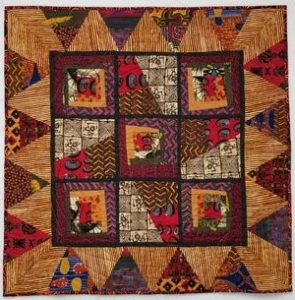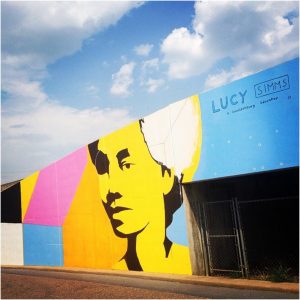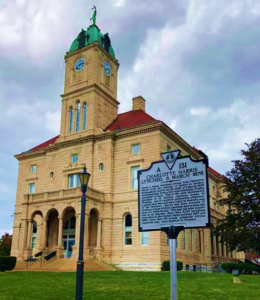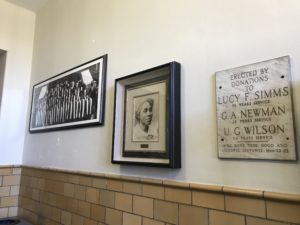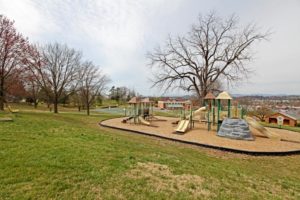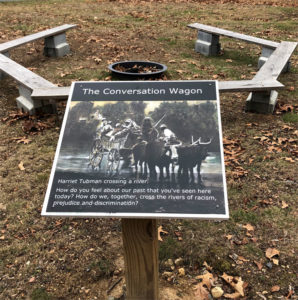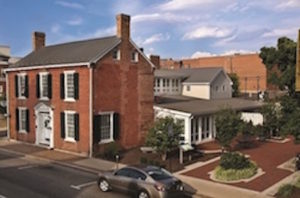Harrisonburg’s African American community has a long and rich history. Today there are numerous sites that bear witness to this history and the contributions of African Americans past and present, from the Lucy Simms Center to the Ralph Sampson Park, to The 150 Franklin Street Gallery, a multicultural art gallery. Harrisonburg is also home to The Furious Flower Poetry Center, the first academic center in the United States devoted to the preservation and promotion of the work of black poets. The center hosts readings and performances by outstanding black poets at all stages of their careers.
Arts and Culture
The 150 Franklin Street Gallery: A multicultural art gallery featuring exhibits from local painters and photographers as well as works by nationally known artists, 150 Franklin Street is a quiet haven for the arts. On permanent display is the Furious Flower Quilt, a piece honoring African American poets. This massive piece alone is worth a trip for its colorful and symbol-filled depiction of some of the most prominent writers in American literature.
Lucy Simms Mural: Visit the Lucy Simms Mural on the west side of the Elizabeth Street Parking Deck in downtown Harrisonburg to see a mural of a ground-breaking local educator whose name also adorns the Lucy Simms Continuing Education Center. You can watch the mural’s creation here.
History
There are many sites in town that offer insight into the history of African American people in Harrisonburg. Court Square once served as the site of slave auctions and the punishment of enslaved peoples. In front of the courthouse is a marker which honors the memory of Charlotte Harris, a local resident and the only African-American woman lynched in Virginia. Harris had been accused of inciting a young African American man to burn the barn of a white farmer. This man was later acquitted on all charges.
For additional historical information visit The Shenandoah Valley Black Heritage Center. The center located in Harrisonburg works to learn, share and illuminate the rich history of Harrisonburg’s African American experience. (Visits by appointment only.) Their site includes area driving tours. Additional local historic information can also be found at the Northeast Neighborhood Association.
Newtown Cemetery: This cemetery (297 Kelley Street), opened in 1868 as the burial place for the freed slaves who founded this African American community, offer testimony to the life of community members and the history that is still alive here. The cemetery is listed on the National Register of Historic Places. Lucy F. Simms, her mother Jane Simms Wilson, her half-brother U. G. Wilson, and Malinda Rice are buried here. Malinda Rice was the mother of Mary Rice Allen, black daughter of Harrisonburg’s only Civil War General, John Robert Jones. In 1873 Malinda Rice, an emancipated slave from Singers Glen, was hired by General and Mrs. Jones as their housekeeper. Two years later, Malinda gave birth to Mary. Contrary to custom, he acknowledged Mary and her brother Willie as his children and supported them financially.
Lucy Simms Center: The Center houses a continuing education program as well as an exhibit commemorating the contributions of the Lucy F. Simms School and the Northeast neighborhood to the city of Harrisonburg. Born enslaved in 1856, Lucy F. Simms went on to receive her degree from Virginia’s Hampton Institute, and eventually settled in Harrisonburg to teach over 1,800 students from three generations of families. She began teaching in Harrisonburg at the age of 17 in 1874 and continued, here until her death in 1934. The Lucy F. Simms School was built soon after her death and served African American students from all over Rockingham County and beyond between 1938 and 1965. This exhibit, spanning 150 years of history, tells the story of the school in terms of its place at the heart of local community life. You can read more about the Lucy Simms School and the education of African American students in Harrisonburg here.
Ralph Sampson Park: Located on East Washington Street on the site of the former Hilltop Plantation (c. 1820-1874) now a city park named for Harrisonburg native and famous basketball player Ralph Sampson Jr. Sampson is a four-time All-Star, an NBA Rookie of the Year and an NBA All-Star Game MVP(1985). Ralph Sampson Park covers 31 acres. The park has two picnic shelters, restroom facilities, two tennis courts, three basketball courts, playground equipment, a sports field, and horseshoe pits and a natural surface walking trail (0.3 miles). This park surrounds the Lucy F. Simms Continuing Education Center.
Harriet Tubman Cultural Center: In this small building (2065 Reservoir St), the remains of the Mabel Memorial Schoolhouse, exhibits and films capture the life and escapades of Harriet Tubman, famous for her work on the Underground Railroad which helped take slaves to freedom before the Civil War. Tours are offered by appointment.
Hardesty-Higgins House Visitor Center: For area information and a map stop in at the Hardesty-Higgins House Visitor Center at 212 S. Main Street. This was the home of Isaac Hardesty, the first mayor of Harrisonburg in 1849. Later in the war, the Strayer sisters were renting the house when Union General Philip H. Sheridan’s army occupied the town in 1864. A young slave woman named Fanny cooked the soldiers’ rations in exchange for a share, which she took to wounded confederates in a nearby hospital. At the end of the occupation, Fanny and her elderly parents left for freedom with Sheridan’s army.
